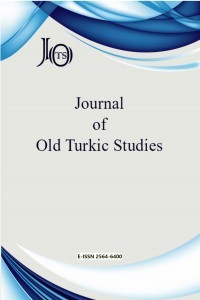Der Einleitungsśloka zur „Lehrschrift über das Eintreten in den Abhidharma“ (T. 1554)
The fragment Mainz 857 (verso) of the Berlin Turfan Collection contains a parallel to text F of the miscellaneous manuscript U 5335 (edited Berliner Turfantexte 34). The vertical lines (columns), which comprise an Old Uyghur translation of the beginning of the prologue to the Abhidharmāvatāra (T. 1554: 入阿毘達磨論 ru apidamo lun), are arranged in such a way that they proceed from right to left, contrary to the usual left-right direction.
Anahtar Kelimeler:
Prologue of the Abhidharmāvatāra, ancient Uyghur translation, script direction, Turfan Collection.
The introductory Śloka to “the Treatise on Entering the Abhidharma” (T. 1554)
The fragment Mainz 857 (verso) of the Berlin Turfan Collection contains a parallel to text F of the miscellaneous manuscript U 5335 (edited Berliner Turfantexte 34). The vertical lines (columns), which comprise an Old Uyghur translation of the beginning of the prologue to the Abhidharmāvatāra (T. 1554: 入阿毘達磨論 ru apidamo lun), are arranged in such a way that they proceed from right to left, contrary to the usual left-right direction.
Keywords:
Prologue of the Abhidharmāvatāra, ancient Uyghur translation, script direction, Turfan Collection.,
___
- Dhammajoti, K. L. (2008). Entrance into the Supreme Doctrine: Skandhila’s Abhidharmāvatāra. University of Hong Kong.
- Elmalı, M. (2015). Eski Uygurca Gramer Terimleri: vibakti-samaz. Kesit Yayınları.
- Hōbōgirin (1978). Dictionnaire encyclopédique du bouddhisme d’après les sources chinoises et japonaises. Publié par l’Académie des Inscriptions et Belles-Lettres. Institut de France avec le patronage de l’Académie du Japon et le concours de l’École Française d’Extrème Orient et de la Maison Franco-japonaise de Tokyo, I-VII (1929-1994). Répertoire du Canon bouddhique sino-japonais.
- Inokuchi, T. (1961). トカラ語及びウテン語の佛典 IV [Tocharische und khotanische Buddhica IV]. 西域文化研究 [Monumenta Serindica]. Hōzōkan.
- Kasai, Y. (2021). Old Uyghur Translations of Buddhist Texts and their Usage. In Brentjes, von S. & Fidora, A. (Eds.), Contact and transmission. Intercultural encounters from late antiquity to the early modern Period II (pp. 13-31). Brepols Publishers.
- Kaygusuz, A. (2021). Buddhistische Bildersprache in alttürkischen Texten. Eine literaturwissenschaftliche und philologische Analyse. Harrassowitz Verlag.
- Kritzer, R. (2010). Entrance into the Supreme Doctrine: Skandhila’s Abhidharmāvatāra, 2nd rev. ed. by K.L. Dhammajoti. Indo-Iranian Journal, 53(3), 265-274. (Rezension).
- Kudara, K. (1980). 入阿毘達磨論の註釋書について [Zum Kommentar des Abhidharmāvatāra-prakaraṇa].印度學佛教學研究 [Journal of Indian and Buddhist Studies], 29(1), 72-77.
- Kudara, K. (1982). ウイグル訳アビダルマ論書に見える論師・論書の梵名 [Sanskritische Namen von Śāstra-Meistern und Śāstra-Werken nach dem uigurischen Abhidharmaśāstra]. 印度学仏教学研究 [Journal of Indian and Buddhist Studies], 31, 112-115.
- Matsuda, K. (1996). 『入阿毘達磨論』のギルギット写本残闕 [Sanskrit Fragment of the Abhidharmavatara in the Gilgit Manuscripts]. 佛教大学仏教学会紀要 [Bulletin of the Association of Buddhist Studies Bukkyo University], 4, 35-42.
- Matsui, D. (2017). 松井太 敦煌⽯窟ウイグル語 モンゴル語題記銘⽂集成 [Uigur and Mongol Inscriptions of the Dunhuang Grottoes]. In Matsui, D. & Arakawa, S. (Eds.), 敦煌石窟多言語資料集成 [Multilingual Source Materials of the Dunhuang Grottoes] (pp. 1-162). Research Institute for Languages and Culture of Asia and Africa.
- Shōgaito, M. (2004). ウイグル文「入阿毘達磨論」の注釈書断片 [Ein uigurisches Fragment des Kommentars zum Abhidharmāvatāra-prakaraṇa]. Contributions to the Studies of Eurasian Languages, 7, 271-295.
- Shōgaito, M. (2013). An Uighur fragment of the ‘Commentaries on abhidharmakośakārikā (倶舎論頌疏)’. Abant İzzet Baysal Üniversitesi Sosyal Bilimler Enstitüsü Dergisi, 13, 341-351.
- Shōgaito, M. (2014). The Uighur Abhidharmakośabhāṣya preserved at the Museum of Ethnography in Stockholm. Harrassowitz Verlag.
- Shōgaito, M. et al. (2015). The Berlin Chinese Text U 5335 Written in Uighur Script. Berliner Turfantexte 34. Brepols Publishers.
- Shōgaito, M. et al. (2018). The Uigur version of the commentary on Abhidharmaprakaraṇa-śāstra preserved at the Museum of Ethnography in Stockholm. In Hayasi, T. et al. (Eds.), ユーラシア諸言語の多様性と動態 -20 号記念号- 追悼 庄垣内正弘先生 [Diversity and Dynamics of Eurasian Languages. The 20th Commemorative Volume. Dedicated to Prof. Dr. Masahiro Shōgaito], 20, 1-68.
- Velthem, van M. (1977). Le traité de la descente dans la profonde loi (Abhidharmāvatāraśāstra) de l’Arhat Skandhila. Louvain-la-Neuve.
- Wilkens, J. (2021). Handwörterbuch des Altuigurischen, Altuigurisch-Deutsch-Türkisch. Universitätsverlag Göttingen.
- Zieme, P. (2014). Ein chinesisch-altuigurischer Abschnitt aus dem „Traktat über das Eintreten in den Abhidharma“ (Abhidharmāvatāra). Türk Dilleri Araştırmaları, 24(2), 305-314.
- Zieme, P. (2020). Buddhist pāramitās as seen from Old Uygur texts. Annual Report of the International Research Institute for Advanced Buddhology (ARIRIAB) at Soka University for the Academic Year 2019, 22, 147-165.
- Zieme, P. (2021). Mount Wutai and Mañjuśrī in Old Uigur Buddhism. In Andrews, S. et al. (Eds.), The Transnational Cult of Mount Wutai. Historical and Comparative Perspectives (pp. 223-237). Brill.
- Yayın Aralığı: Yılda 2 Sayı
- Başlangıç: 2017
- Yayıncı: Erdem UÇAR
Sayıdaki Diğer Makaleler
Budist Uygurlarda Abhiseka Ritüeli
Göz Hastalıkları ve Tedavileri Üzerine Eski Uygurca Sūtra’lardan Parçalar
Eine Gelehrte der Seidenstraße. Zum 120. Geburtstag von Annemarie von Gabain am 4. Juli 2021
Der Einleitungsśloka zur „Lehrschrift über das Eintreten in den Abhidharma“ (T. 1554)
Orhon Yazıtları’ndaki Ötükän Yıš İbaresinin Yeni Yorumu
Cüveynî’nin Târîh-i Cihân-Güşâ Adlı Yazmasına Eklenen Sözlük
